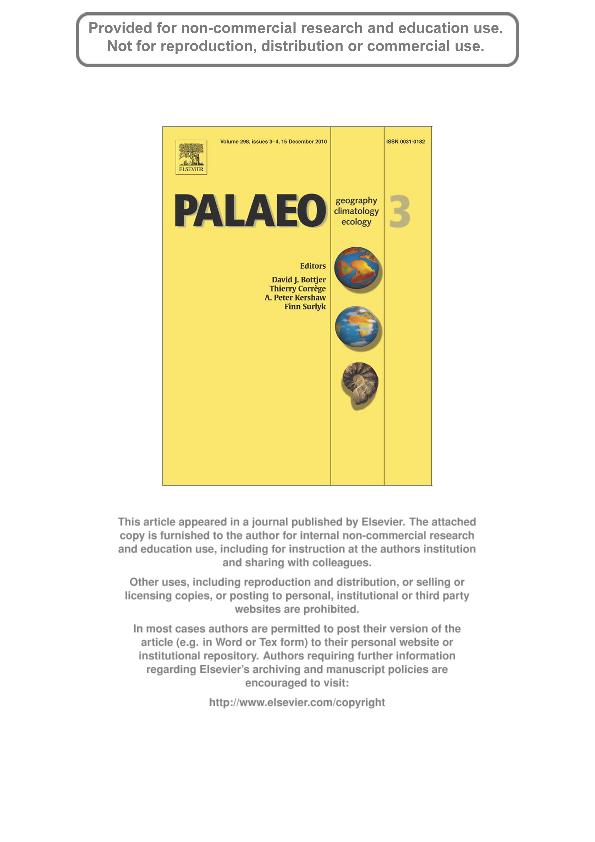Artículo
Holocene vegetation changes along the southeastern coast of the Argentinean Pampa grasslands in relation to sea-level fluctuations and climatic variability: Palynological analysis of alluvial sequences from Arroyo Claromecó
Fecha de publicación:
12/2010
Editorial:
Elsevier Science
Revista:
Palaeogeography, Palaeoclimatology, Palaeoecology
ISSN:
0031-0182
Idioma:
Inglés
Tipo de recurso:
Artículo publicado
Clasificación temática:
Resumen
Here we present palynological records from alluvial deposits in four outcrop sequences along the lower reaches of Arroyo Claromecó, Buenos Aires Province, Argentina (38° 50' S latitude, 60° 05' W longitude). These data indicate development of soils and grasslands with associated halophytic vegetation in the higher elevations of the floodplains between ca. 7200 and 600014C yr BP (ca. 8000 and 7000cal yr BP). At lower elevations halophytic saltmarsh vegetation was replaced by wetland communities (sedges) in response to a sea-level highstand at 650014C yr BP (ca.7400cal yr BP). Soils were buried by expanding wetlands at ca.600014C yr BP, a trend that persisted until ca. 340014C yr BP (ca. 3700cal yr BP). Over this interval we observe repeated fluctuations between grassland and halophytic vegetation in response to variations in water level and physical-chemical conditions resulting from desiccation or flooding events. These variations are caused by hydrologic variability in a subhumid-dry climatic mean state. Channel incision occurred between ca. 3400 and 250014C yr BP (ca.3700-3200cal yr BP), concurrent with sporadic and intermittent sediment deposition at higher elevations of the floodplain. The pollen record from the paleochannel infilling indicate grasses accompanied by halophytic taxa between ca. 2500 and 80014C yr BP (3200 and 700cal yr BP) deposited in a shallow brackish-to-fresh water body. The palynological spectra from sediments deposited sporadically at higher elevations show halophytic vegetation and a trend toward wetland desiccation followed by development of psammophytic communities after ca. 110014C yr BP. The tops of the alluvial sequences are covered by sand dunes whose modern spectra are characterized by psammophytic vegetation along with exotic tree taxa. Our results and inferences are consistent with previous studies and provide more detailed insights into the impacts of Holocene sea-level and climatic variations, aspects that are relevant for the coastal Pampa grasslands under various scenarios in a warming world.
Palabras clave:
Climatic Variability
,
Coastal Pampa Grasslands
,
Holocene
,
Palynology
,
Sea-Level
Archivos asociados
Licencia
Identificadores
Colecciones
Articulos(MACNBR)
Articulos de MUSEO ARG.DE CS.NAT "BERNARDINO RIVADAVIA"
Articulos de MUSEO ARG.DE CS.NAT "BERNARDINO RIVADAVIA"
Citación
Vilanova, Isabel; Prieto, Aldo Raul; Stutz, Silvina Maria; Bettis, E. Arthur; Holocene vegetation changes along the southeastern coast of the Argentinean Pampa grasslands in relation to sea-level fluctuations and climatic variability: Palynological analysis of alluvial sequences from Arroyo Claromecó; Elsevier Science; Palaeogeography, Palaeoclimatology, Palaeoecology; 298; 3-4; 12-2010; 210-223
Compartir
Altmétricas




